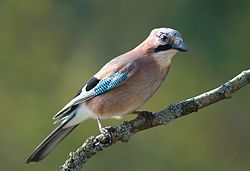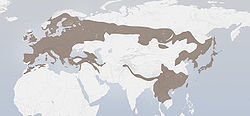| Eurasian jay Temporal range: | |
|---|---|
 | |
| Nominate subspecies in Belgium | |
| Scientific classification | |
| Kingdom: | Animalia |
| Phylum: | Chordata |
| Class: | Aves |
| Order: | Passeriformes |
| Family: | Corvidae |
| Genus: | Garrulus |
| Species: | G. glandarius |
| Binomial name | |
| Garrulus glandarius | |
| Subspecies | |
33 (in eight groups) - see text | |
 | |
| Range | |
| Synonyms | |
| |
The Eurasian jay (Garrulus glandarius), also known simply as the jay without any epithets in the United Kingdom and Ireland, is a species of passerine bird in the crow family Corvidae. It has pinkish brown plumage with a black stripe on each side of a whitish throat, a bright blue panel on the upper wing and a black tail. The Eurasian jay is a woodland bird that occurs over a vast region from western Europe and north-west Africa to the Indian subcontinent and farther to the eastern seaboard of Asia and down into south-east Asia. Across this vast range, several distinct racial forms have evolved which look different from each other, especially when comparing forms at the extremes of its range.







